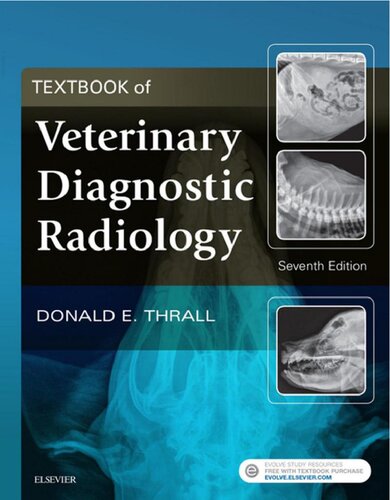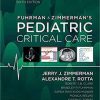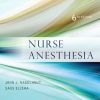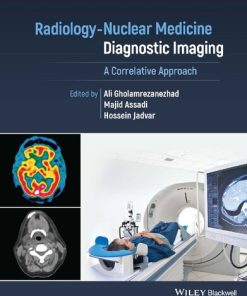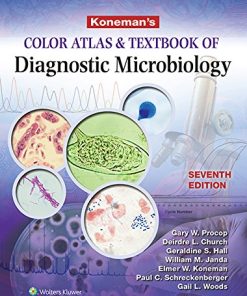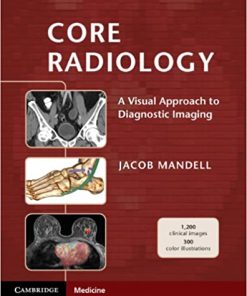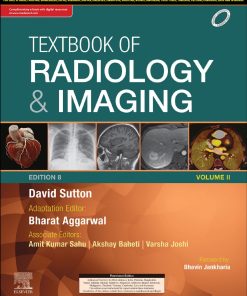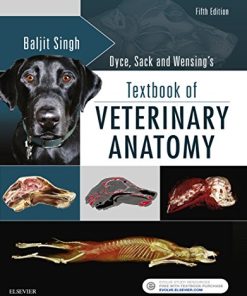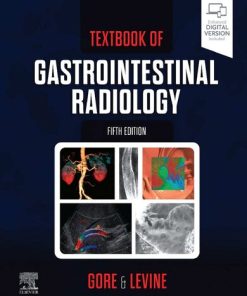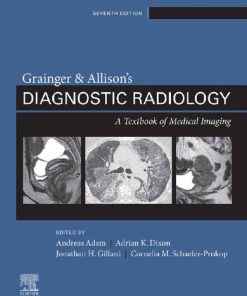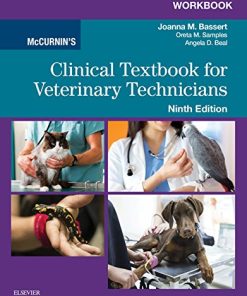Textbook of veterinary diagnostic radiology 7th Edition by Donald Thrall 0323482462 9780323482462
$50.00 Original price was: $50.00.$25.00Current price is: $25.00.
Textbook of veterinary diagnostic radiology 7th Edition by Donald E. Thrall – Ebook PDF Instant Download/DeliveryISBN: 0323482462, 9780323482462
Full download Textbook of veterinary diagnostic radiology 7th Edition after payment.
Product details:
ISBN-10 : 0323482462
ISBN-13 : 9780323482462
Author : Donald E. Thrall
Learn the latest advances in veterinary diagnostic radiology! Textbook of Veterinary Diagnostic Radiology, 7th Edition, is a one-stop resource covering the principles of radiographic technique and interpretation for dogs, cats, and horses. Within this bestselling text, high-quality radiographic images accompany clear coverage of diagnostic radiology, ultrasound, MRI, and CT. User-friendly direction helps you to develop essential skills in patient positioning, radiographic technique and safety measures, normal and abnormal anatomy, radiographic viewing and interpretation, and alternative imaging modalities. This new edition has been thoroughly revised to include important advances in the field, information about contrast media, dental radiography, and more!
Textbook of veterinary diagnostic radiology 7th Table of contents:
Section I Physics and Principles of Interpretation
Introduction
Chapter 1 Radiation Protection and Physics of Diagnostic Radiology
Basic Properties of X-Rays
Radiation Protection
Production of X-Rays
Interaction of Radiation With Matter
Basic Concept of Making a Radiograph
Factors Affecting Image Detail
Distortion
Factors Affecting Contrast
Film Processing
References
Chapter 2 Digital Radiographic Imaging
What Is Digital Radiographic Imaging?
The Digital Image File
The Components of a Digital Image
Digital Radiography Acquisition Hardware
Image Processing and Viewing
Digital Versus Analog Imaging
Improved Image Accessibility and Consolidated Image Storage
Artifacts
References
Chapter 3 Canine and Feline Dental Radiographic Technique
Dental Nomenclature
Projection Geometry
Making Dental Radiographs
References
Chapter 4 Physics of Ultrasound Imaging
Physical Principles of Ultrasound Waves
Ultrasound Wave Interaction With Matter
Transducers
Display
Basic Scanner Controls
Principles of Interpretation
Artifacts
Doppler Techniques
Doppler Modes
Doppler Artifacts
References
Chapter 5 Principles of Computed Tomography and Magnetic Resonance Imaging
The Role of Computed Tomography and Magnetic Resonance Imaging in Veterinary Practice
Image Formation: General Concepts
Computed Tomography
Cone-Beam Computed Tomography
Magnetic Resonance Imaging
References
Chapter 6 Radiographic, Computed Tomography, and Magnetic Resonance Contrast Media
Introduction
Radiographic Contrast Media
Barium Contrast Agents
Iodine–Based Contrast Media
Negative Contrast Agents
Magnetic Resonance Imaging Contrast Media
Ultrasound Contrast Media
References
Chapter 7 Introduction to Radiographic Interpretation
Image Formation and Differential Absorption
Radiographic Opacities
Radiographic Geometry and Thinking in Three Dimensions
Role of Perception in Interpretation
References
Section II The Axial Skeleton: Canine, Feline, and Equine
Introduction
Chapter 8 Radiographic Anatomy of the Axial Skeleton
References
Chapter 9 Basic Principles of Radiographic Interpretation of the Axial Skeleton
Skull
Spine
References
Chapter 10 Canine and Feline Dental Disease
Normal Radiographic Anatomy
Dental Nomenclature
Orientation of Images
Tooth and Supporting Structures
Dental Radiology: Disease Processes
Periodontal Disease
Diseases of the Tooth Surface
Endodontic Disease
Tooth Resorption
Tooth Trauma
Odontogenic Cysts
Dentigerous Cysts
Eruption Cysts
Periapical Cysts (Radicular Cyst)
Lateral Periodontal Cyst
Odontogenic Keratocyst or Canine Odontogenic Parakeratinized Cyst
Odontogenic Tumors
Epithelial Tumors
References
Chapter 11 The Cranial Nasal Cavities
Normal Anatomy
Congenital Anomalies
Metabolic Anomalies
Neoplastic Abnormalities
Infectious Disorders
Traumatic Injuries
Miscellaneous Diseases
References
Chapter 12 Magnetic Resonance Imaging Features of Brain Disease in Small Animals
Basic Magnetic Resonance Examination of the Brain
Common Intracranial Conditions in Small Animals and Their Magnetic Resonance Imaging Characteristics
Miscellaneous Conditions
Brain Neoplasia
Invasive Extracranial Tumors
Vascular Disruptions
References
Chapter 13 The Equine Head
Radiography Versus Other Imaging Modalities
Abnormalities of the Equine Head
References
Chapter 14 Canine and Feline Vertebrae
Anatomic Considerations
Anomalies of the Vertebral Column
Fracture and Luxation
Intervertebral Disc Disease
Inflammatory Conditions
Degenerative Conditions
Neoplasia
Metabolic and Unclassified Conditions
References
Chapter 15 Magnetic Resonance Imaging and Computed Tomography Features of Canine and Feline Spinal Cord Disease
Normal Appearance of the Spine on Computed Tomography and Magnetic Resonance Imaging
Intervertebral Disc Disease
Cervical Spondylomyelopathy
Cystic Changes of the Spine
Spinal Tumors
Myelomalacia
Ischemic Myelopathy
Spinal Trauma
Inflammatory/Infectious Conditions
Vertebral Anomalies
Syringomyelia
References
Section III The Appendicular Skeleton: Canine, Feline, and Equine
Introduction
Chapter 16 Radiographic Anatomy of the Appendicular Skeleton
References
Chapter 17 Principles of Radiographic Interpretation of the Appendicular Skeleton
Positioning: Dog and Cat
Positioning: Horse
Oblique Projections
Aggressive Versus Nonaggressive Bone Lesions
References
Chapter 18 Orthopedic Diseases of Young and Growing Dogs and Cats
Disorders Primarily Affecting Joints
Disorders Primarily Affecting Bone
Generalized Bone Disorders
Epiphyseal Dysplasias
Disorders Primarily Affecting the Metaphysis and Physis
References
Chapter 19 Fracture Healing and Complications in Dogs
Bone Tissue
Bone Healing
Factors Affecting Bone Healing
Promoting Fracture Healing
Fracture Identification
Fracture Classification
Radiographic Evaluation of Bone Healing
Complications
References
Chapter 20 Radiographic Features of Bone Tumors and Bone Infections in Dogs and Cats
Primary Bone Tumors
Fungal Bone Infections
Bacterial Bone Infections
Protozoan Bone Infections
Metastatic Bone Cancer
Subungual Tumors Versus Subungual Infections
References
Chapter 21 Radiographic Signs of Joint Disease in Dogs and Cats
Radiographic Signs of Joint Disease
Sesamoid Bones
Contrast Radiography of Joints
Sesamoid Disease
Hip Dysplasia
Trauma Involving the Osseous Components of Joints
Sprains Affecting Joints
Tendons, Desmopathies
Hypervitaminosis a
Mucopolysaccharidosis
Scottish Fold Chondro-Osseous Dysplasia
Hemarthrosis
Septic Arthritis
Immune-Mediated Arthropathies
The Synovium
References
Chapter 22 Equine Stifle and Tarsus
The Stifle
The Tarsus
References
Chapter 23 Equine Carpus
Anatomy
Normal Variations
Abnormalities
References
Chapter 24 Equine Metacarpus and Metatarsus
Anatomy
Normal Radiographic and Ultrasonographic Variations
Abnormalities
References
Chapter 25 Equine Metacarpophalangeal and Metatarsophalangeal Joint
Anatomy
Radiographic Examination
Alternative Imaging Modalities
Radiographic Interpretation of Diseases of the Metacarpophalangeal/Metatarsophalangeal Articulation
References
Chapter 26 Equine Phalanges
Technical Factors
Normal Radiographic Anatomy (Including Variations)
Radiographic Changes Caused by Diseases of the Phalanges
Fracture Disease
Infection
Osteoarthritis
Laminitis
Flexural Deformity of the Interphalangeal Joints
Osseous Cystlike Lesions
Pedal Osteitis
Collateral Cartilages
Hoof Balance
Miscellaneous Diseases Affecting the Phalanges
References
Chapter 27 Equine Navicular Bone
Anatomy
Indications for Radiography
Preparation for Radiographic Evaluation
Radiographic Views
Normal Radiographic Appearance
Navicular Disease
Fractures
Navicular Sepsis
Miscellaneous Conditions
Ultrasonographic Evaluation of the Navicular Bone and Associated Soft Tissue Structures
Magnetic Resonance and Computed Tomographic Evaluation of the Navicular Bone
References
Section IV The Thoracic Cavity: Canine, Feline, and Equine
Introduction
Chapter 28 Principles of Radiographic Interpretation of the Thorax
Nomenclature
Positioning: Dog and Cat
Positioning: Horse
Radiographic Technique: Dog and Cat
Radiographic Technique: Horse
Ancillary Factors
Interpretation Paradigm
References
Chapter 29 Canine and Feline Larynx and Trachea
Anatomic Considerations: Normal Anatomy and Radiographic Technique
Radiographic Signs of Disease
Ultrasound
Computed Tomography and Magnetic Resonance Imaging
References
Chapter 30 Canine and Feline Esophagus
Relative Value of Radiography, Contrast Esophagraphy, Fluoroscopy, and Alternative Imaging Procedures
Anatomy and Physiologic Considerations
Normal Radiographic Appearance
Survey Radiographic Abnormalities
Contrast Esophagraphy Techniques
Dysphagia
Esophageal Dilatation
Foreign Bodies
Vascular Ring Anomalies
Inflammatory Diseases
Diverticula, Perforation, and Fistula Formation
Esophageal Varices
References
Chapter 31 Canine and Feline Thoracic Wall
Normal Radiographic Appearance
Congenital and Developmental Abnormalities
Thoracic Wall Trauma
Rib Tumors and Infection
Sternebral Tumors and Infection
Soft Tissue Tumors and Infection
Alternate Imaging of the Thoracic Wall
References
Chapter 32 Canine and Feline Diaphragm
Normal Radiographic Anatomy
Radiographic Signs of Diaphragmatic Disease
Diaphragmatic Diseases
References
Chapter 33 Canine and Feline Mediastinum
Normal Anatomy
Pathologic Mediastinal Conditions
References
Chapter 34 Canine and Feline Pleural Space
Pleural Anatomy
Normal Radiographic Appearance of Pleura and Pleural Thickening
Pleural Fluid
Pneumothorax
References
Chapter 35 Canine and Feline Cardiovascular System
Radiographic Signs
References
Chapter 36 Canine and Feline Lung
Pulmonary Anatomy
Radiographic Appearance of Normal Lung
Paradigms for Assessing Pulmonary Disease
Specific Pulmonary Conditions
References
Chapter 37 Equine Lower Respiratory System
Radiographic Technique
Normal Anatomy
Alternative Imaging Modalities
Pulmonary Disease
Pleural Disease
Mediastinal Disease
Tracheal Disease
Esophageal Disease
Cardiac Disease
References
Section V Abdominal Cavity: Canine and Feline
Introduction
Chapter 38 Principles of Radiographic Interpretation of the Abdomen
Nomenclature
Preparation
Positioning—Dog and Cat
Positioning—Horse
Radiographic Technique—Dog and Cat
Radiographic Technique—Horse
Ancillary Factors
Interpretation Paradigm
References
Chapter 39 Peritoneal Space
Normal Anatomy and Imaging Procedures
Peritoneal and Retroperitoneal Disease
Increased Abdominal Surface Visualization
Normal Anatomy and Imaging of the Abdominal Wall
Pancreas
Disease of the Pancreas
Adrenal Glands
References
Chapter 40 Liver and Spleen
Radiology of the Liver
Radiology of the Spleen
References
Chapter 41 Kidneys and Ureters
Normal Anatomy and Imaging Procedures
Renal Diseases
Diseases of the Ureters
References
Chapter 42 Urinary Bladder
Normal Anatomy
Radiographic Signs of Urinary Bladder Disease
Contrast Cystography
Sonography
References
Chapter 43 Urethra
Anatomy
Radiography and Urethrography
Ultrasound Examination of the Urethra
Diseases of the Urethra
References
Chapter 44 Prostate Gland
Normal Anatomy and Radiographic Appearance
Diseases of the Prostate Gland
Special Radiographic Procedures for Evaluating the Prostate Gland
Sonography for Evaluating the Prostate Gland
References
Chapter 45 Uterus, Ovaries, and Testes
Uterus
Ovaries and Testes
Ovaries
Testicles
Intersex Conditions
References
Chapter 46 Stomach
Normal Anatomy
Imaging Procedures
Gastric Diseases
Changes in Gastric Shape and Size
Abnormal Gastric Content
Gastric Wall Changes
References
Chapter 47 Small Bowel
The Normal Small Bowel
Abnormal Small Bowel
References
Chapter 48 Large Bowel
Imaging Options for Large Bowel Disease
Normal Radiographic Anatomy
Radiographic Techniques of Large Bowel Evaluation
Radiographic Findings in Large Bowel Disease
Ultrasonographic Evaluation of the Large Bowel
Computed Tomographic Evaluation of the Large Bowel
People also search for Textbook of veterinary diagnostic radiology 7th:
thrall de textbook of veterinary diagnostic radiology
textbook of veterinary diagnostic radiology 6th ed
textbook of veterinary diagnostic radiology 6th edition
textbook of veterinary diagnostic radiology 7th
veterinary diagnostic imaging and teleradiology
Tags: Textbook, veterinary, diagnostic radiology, Donald Thrall
You may also like…
Medicine - Radiology
Radiology-Nuclear Medicine Diagnostic Imaging 1st Edition Ali Gholamrezanezhad
Uncategorized
Medicine - Radiology
Uncategorized
Dyce, Sack and Wensing’s Textbook of Veterinary Anatomy E Book 5th Edition, (Ebook PDF)
Medicine - Radiology
Textbook of Gastrointestinal Radiology 5th Edition Richard M. Gore
Uncategorized
Workbook for McCurnin’s Clinical Textbook for Veterinary Technicians E Book 9th Edition, (Ebook PDF)


